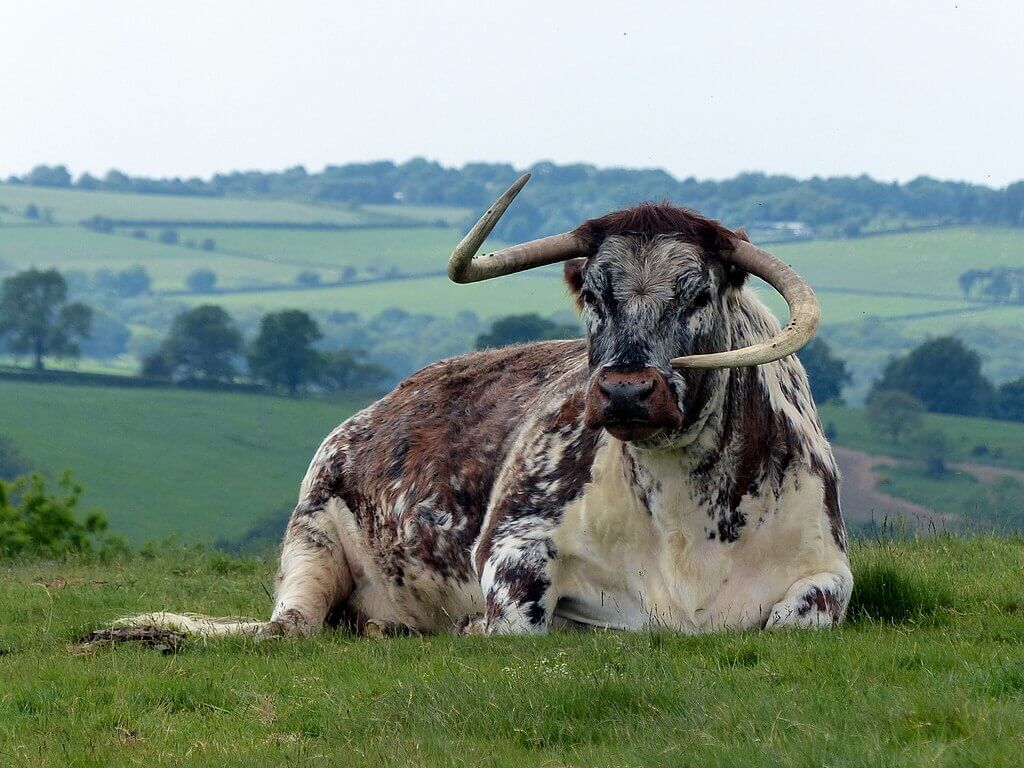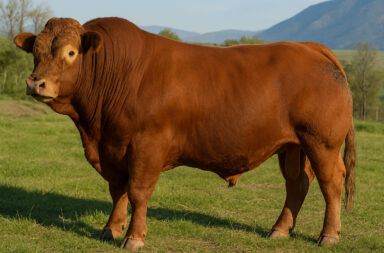
Image from Wikimedia by Mat Fascione.
English Longhorn Cattle.
History
Let’s start with the origins of the English Longhorn cattle. They came from the Craven district of Northern England. Between 1725 and 1795, A man named Robert Bakewell worked to improve livestock breeds for meat production to meet the growing demand for urban workers during the Industrial Revolution. He crossed a Horned Heifer with a Westmoreland bull, which resulted in the Dishley Longhorn breed. which we now call the English longhorn cattle.
Then he applied his inbreeding technique to further improve the Dishley Longhorn or English longhorn. His improved breed was effective and gradually proliferated to the English mainland. Until the 1800s, the English Long Horn was dominant beef-producing cow breed in England.
This breed was also used as a drought animal, and its milk was used to produce dairy products like cheese and butter. Interestingly, their long, curved horns were also utilized in making household stuff like buttons, cups, lamps, containers, and even glass substitute.
Afterward, the breed lost its position to modern short-horn cattle. Over the next 200 years, the breed became scarce. But fortunately, the Rare Breeds Survival Trust helped to preserve the breed (1980). Also, In 1878 a breed society was established, and it published a herd-book.
In Robert Bakewell’s time, there was no formal breeding program. Typically, cattle grazed on a particular land owned by landlords, and the landowner’s preferred bull would have mated with the cows. However, Robert Bakewell’s cattle breeding technique gave a breakthrough in cattle breed development. And that’s why he is considered as Initiator of the Inbreeding technique.
English longhorn at a glance

Designed by Freepik
Weight: Cow 500-600 kg (1102-1326 lb.), and bull 1000-1200 kg (2204-2645 lb.)
Height: Cow height range is 130-140 cm (51-55 inches), and bull maximum height range is 150 cm (59 inches).
Color: They can display various colors (red, red brindle, grey brindle, and brown)
Temperament: Docile and calm.
Breed Purpose: Meat production.
Hardiness: Mediocre.
Calving difficulty: The English longhorn calves easily and usually does not require human intervention.
Beef quality: Juicy, tender, and delicious.
Characteristics
The English longhorn is a large, moderately hardy, beef cattle breed. Cows generally weigh between 500 and 650 kg, while bulls weigh between 1000 and 1200 kg. The height of cow’s ranges from 130 to 140 cm, whereas bulls can reach heights of up to 150 cm.
English long-horn colors vary, including red, red brindle, grey brindle, and brown. These colors are complemented by a distinctive color pattern called ‘finching’—a white line that runs along their spine and tail.
Another prominent feature of them is their long, curved horn. At first glance, these horns may appear intimidating. But they are docile, which is the opposite of your initial feeling. After observing them for some time, your first impression of intimidation will likely fade away.
Besides, English longhorn has a longer lifespan than other normal breeds and gives birth even at older age. They don’t yield large quantities of milk, but their milk contains 6% butter fat and remains consistence throughout the lactation period. Which is helpful for calf growth. They are also known for being attentive and nurturing mothers.
Furthermore, they give birth to calves easily. Generally, human intervention is not necessary during delivery. The English longhorn cow has wide birth canal, prominent hook bones, and deep pin bones, making them one of the calving ease cattle breeds.
Moreover, their meat is lean and contains marbling (small fat streaks inside the meat), which makes their beef juicy, tender, and delicious.
English Longhorn cattle are truly special! From their rich history to their calm nature and tasty beef, they stand out in many ways. Thanks to the conservation efforts of Rare Breeds Survival organization. For them, this amazing breed is still around today. With their simple look, easy calving, and great meat, English Longhorns are a wonderful choice for farmers and cattle lovers.


